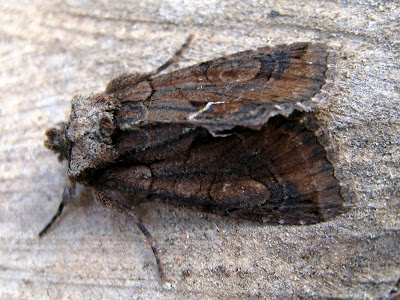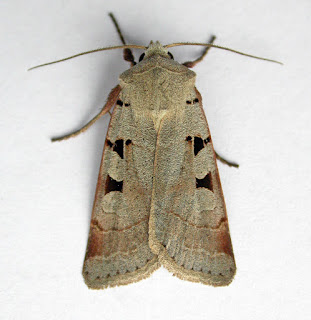Even though it was chucking it down with rain when I went out to close things down at 5.30am this morning, the overcast and much warmer night made a big difference to the garden catch here, 45 species coming as a very nice surprise when compared to the trap results of the last few weeks. Caught were
Tinea semifulvella (1),
Depressaria radiella (1),
Blastobasis lacticolella (1),
Pandemis cinnamomeana (1),
Acleris rhombana (1),
Acleris variegana (1),
Archips podana (2),
Clepsis consimilana (2),
Celypha lacunana (2),
Eudonia pallida (2),
Hypsopygia costalis (1),
Acrobasis consociella (1), Maiden's Blush (1), Garden Carpet (1), Common Marbled Carpet (7), Mallow (1), Brimstone Moth (9), Dusky Thorn (11), Willow Beauty (1), Ruby Tiger (1), Turnip Moth (2), Shuttle-shaped Dart (1), Large Yellow Underwing (20), Lesser Yellow Underwing (1), Broad-bordered Yellow Underwing (6), Small Square-spot (1), Setaceous Hebrew Character (14), Square-spot Rustic (51), Common Wainscot (16), Deep-brown Dart (3), Black Rustic (20), Beaded Chestnut (15), Lunar Underwing (42), Centre-barred Sallow (9), Pink-barred Sallow (4), Sallow (3), Dusky-lemon Sallow (1), Old Lady (1), Angle Shades (1), Small Wainscot (1), Rosy Rustic (4), Scarce Bordered Straw (1), Burnished Brass (2), Straw Dot (2) & Snout (3). Only
Pandemis cinnamomeana and Dusky-lemon Sallow were new for the year, but it was good to see another Scarce Bordered Straw even if it was in somewhat less than pristine condition! Square-spot Rustic seems to have had a late burst of activity here, this being the highest nightly count I've had all season.
 |
| Scarce Bordered Straw, Westcott 24th September |
I also took a couple of traps to
Bernwood Forest last night for the usual three hour session but the results were quite poor in comparison (...and I got soaked there too!). Brindled Green and Barred Sallow were first sightings for me this year but otherwise there was nothing of particular note amongst the macros. I'd hoped to see Oak Lutestring which, oddly, I've never managed to find anywhere at Bernwood in nine consecutive years of regular recording at the site. Once again it failed to appear, this despite the fact that Paul Waring trapped the moth in good numbers during 1984/85 when he was at Oxford Polytechnic and the habitat would seem still to be perfect for it. There has only been one subsequent record at Bernwood and that was from a suspiciously early date in August 2006. There's no shortage of recent Bucks sightings for the species, though, and it is still found in some of the other woodlands in the greater Bernwood area (Finemere Wood, for example). Micros last night were in short supply but it was nice to see
Zelleria hepariella as well as three examples of the uncommon aspen-feeding tortrix
Epinotia maculana.
 |
| Epinotia maculana, Bernwood 24th September |
Dave Wilton
Westcott, Bucks



















































